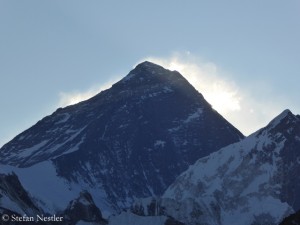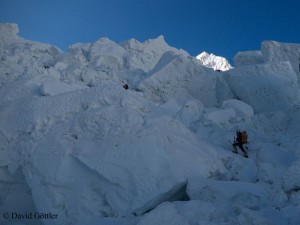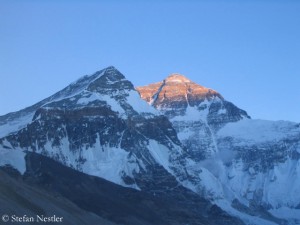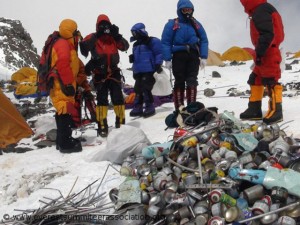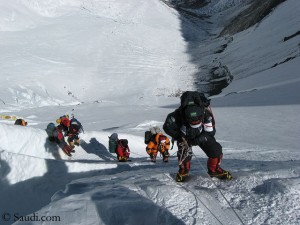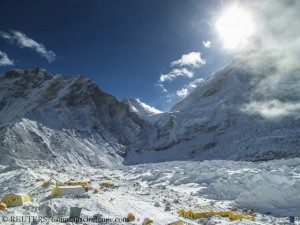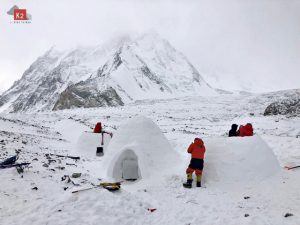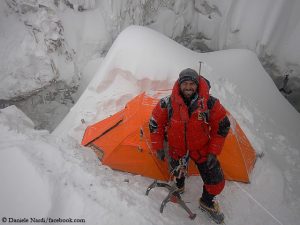Ten popular Everest errors
The Everest spring season is gaining momentum. The Base Camp on the Nepalese side of Mount Everest is filling. According to the government in Kathmandu, 279 climbers from 38 countries have registered for the highest mountain on earth. The Icefall Doctors have meanwhile prepared the route all the way up to Camp 2 at 6,400 meters. The teams who want to climb Everest from the Tibetan north side, have also received now their permits from the Chinese authorities and are heading to Tibet. It’s going to kick off there too. Before the media Everest season begins, I would like to correct some reoccurring errors.
1) Everest is a safe mountain.
Granted, the technical climbing difficulties on the two normal routes may be limited because the way via the Southeast Ridge as well as the route via the Northeast Ridge are secured with fixed ropes up to the summit. But that alone doesn’t make Everest a safe mountain. Finally, it is 8,850 meters high, where oxygen is pressed into the lungs with only one-third of the pressure compared to sea level. Also an ascent with breathing mask is not chicken feed. Even if it is really true that Everest in case of using bottled oxygen is downgraded to a six-thousander, you have to manage to get to the top. In addition, climate change has increased the objective dangers. Parts of the route that were previously almost always snowy, are now frequently free from snow and ice. Rockfall is threatening in the Lhotse flank. And the danger of avalanches has increased, not only in the Khumbu Icefall.
2) Everest is a killer mountain.
The opposite to 1) is wrong as well. Although there were no summit successes from the south side in the last two years, but two avalanche incidents with a total of 35 dead, Mount Everest is still far from being one the most dangerous eight-thousanders. On the one hand about 280 people have died so far on the highest mountain on earth, but there have been more than 7,000 ascents on the other hand. This ratio makes Everest belong even more to the category of the secure than of the extremely dangerous eight-thousanders. Most deaths per ascents have been recorded on Annapurna, on the second place of this “fatality ranking” follows K 2.
3) Everest is no longer a mountain for top climbers.
20 routes have been climbed on Everest, plus several variations of these ways. This does not mean that there is a lack of other options. So far only two routes have been climbed in the Kangchung Face, in recent years the Everest East Face was almost always deserted. Furthermore there should still be possible new ascent routes via the North and the Southwest Face. Not to mention the ultimate challenge, the “Horseshoe Route”: up Nuptse West Ridge, traversing the summits of Lhotse and Everest and descending via Everest West Ridge to the starting point.
4) Everest is a garbage dump.
There have been garbage regulations for Everest expeditions for decades. The mountaineers are obliged to dig or burn their organic waste. Recyclable material such as plastic or glass must be returned to Kathmandu as well as empty oxygen bottles or batteries. Anyone who breaches the rules risks not getting back his garbage deposit of US $ 4,000. In addition, several eco-expeditions have collected tons of garbage from Everest, from the period when mountaineers made little thoughts about environmental protection. Many mountains in the European Alps are even more garbage dumps than Mount Everest.
5) Everest is littered with corpses.
It is true that Everest summit aspirants should mentally be prepared to pass some bodies of dead climbers. But it is not that the route is “paved with corpses”, as reports suggest repeatedly. Many of the climbers who died of exhaustion were “buried” in crevasses or their corpses were pushed down the Everest walls by other climbers. Sometimes a storm does this job too.
6) The moral of Everest Sherpas has been lost.
It’s like anywhere: If many people are on the way, you will find some black sheep. In spring 2013, Sherpas attacked Simone Moro, Ueli Steck and Jonathan Griffith in Everest high camp and a year later there were threats of violence against climbers who disagreed with the premature end of the season after the deadly avalanche in the Khumbu Icefall. But it is dishonest to conclude that now all Sherpas tend to violence or no longer do their job properly. More and more Sherpas acquire international certificates as mountain guides. The Nepal Mountaineering Association (NMA) is offering regularly training courses for local climbers. Undoubtedly, the young, well-trained Sherpa climbers act more self-confident. They are aware of their skills and want to be treated as fully-fledged climbers – and not as lackeys.
7) Everest should be closed.
Who would benefit? Perhaps the advocates of a mainly Western climbing philosophy, but certainly not the people of Khumbu, who strongly depend on the income of Everest tourism: local mountain guides, Climbing Sherpas, cooks and kitchen helpers in Base Camp, porters, owners of lodges and shops on the way to Everest, farmers and the families of these all. The Western critics should ask themselves whether mountains like Mont Blanc in the Alps or Denali in Alaska should have to be closed with the same arguments they use only for Everest.
8) The government will do the job.
If there is anything to be learnt from what happened on Everest in the past years, it is this: The government of Nepal is talking more than acting. Again and again politicians of the competent Ministry of Tourism present proposals for new Everest rules, but only to make headlines. As good as nothing is implemented. Even for a simple decision as to extend the permits after the disasters of the last two years, the authorities in Kathmandu needed almost a year each. Virtually all reforms fail, likely because the government itself makes big profit on Everest. It remains in the dark, where exactly the money from the sale of the permits goes – $ 11,000 per climber at all.
9) The climbers are capable of “managing” Everest on their own.
Also at that point, the main counterargument is the business that is made on and with Everest. At the end of the day, every entrepreneur wants to be in the black. The more clients reach the summit, the better is his reputation, and therefore he will likely increase his profit in the following year. As a result one or the other expedition leader will show selfishness on the mountain, according to the motto: Why should I take care of the other groups? What is really needed is to “manage” the mountain to prevent that all ascend on the same day therefore causing traffic jams at the key points of the route. It might work, but also among the expedition leaders, there are black sheep.
10) One should not report about Everest.
Mount Everest is the highest mountain in the world. Therefore, there will always be mountaineers who want to climb it. And most probably people will always be interested in Everest. That’s the main reason why we have to report about what is happening there – without glossing over, but also without demonizing. Just like anywhere else in the world, it applies on Everest too: You will not solve a problem by keeping quiet about it.



